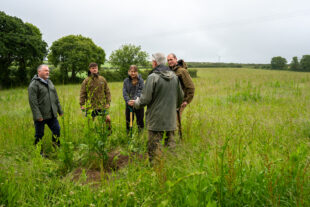https://defrafarming.blog.gov.uk/sustainable-farming-incentive-pilot-guidance-use-controlled-traffic-farming/
Use controlled traffic farming
The guidance on this page is for SFI pilot participants only. Please visit GOV.UK for the official Sustainable Farming Incentive scheme guidance.
Find out how land managers can reduce soil compaction, improve soil health and reduce runoff by using controlled traffic farming.
If you’re completing this action as part of the Sustainable Farming Incentive pilot, how you do it is up to you.
The advice on this page can help you get better environmental and business benefits, but you do not have to follow it to get paid.
Why to use controlled traffic farming
Driving on fields with farm machinery compacts soil and damages the soil structure. Controlled traffic farming reduces soil compaction by limiting all farm machinery to fixed tramlines.
Even machinery with low pressure tyres can damage soil.
You’ll drive on 25% to 40% of the field during farming operations in one season using controlled traffic farming. This is compared to 85% in a conventionally ploughed field.
The benefits of controlled traffic farming
Controlled traffic farming can lead to increased yields of:
- more than 30% in forage grass
- more than 25% in forage maize
- more than 20% in potatoes
- 12% to 15% in combinable crops
Controlled traffic farming reduces soil compaction and improves soil structure. Good soil structure:
- improves nutrient uptake by crops, which improves growth at lower nutrient levels
- allows more water to infiltrate the soil, so more water is available to crops and the risk of flooding is lower
- reduces erosion and runoff of pesticides, fertile topsoil, and nutrients like phosphate
Controlled traffic farming reduces the need for deep cultivations, which:
- improves soil biology, as deep cultivations damage soil fauna, like worms
- lowers labour and fuel costs
Environmental benefits of controlled traffic farming include:
- more carbon captured and stored by the soil as organic matter
- lower greenhouse gas emissions from machinery and less nitrous oxide lost from the soil
Where to use controlled traffic farming
You can use controlled traffic farming on any arable, grassland, mixed or horticultural farm. It works well with no-till or min-till farming.
You’ll get the most benefit on soils that are prone to compaction. These are usually the heavier clay, clay loam and silty clay loam soils.
Before you start using controlled traffic farming
Use a runoff and soil erosion risk assessment to identify fields with poor soil structure or soil prone to compaction.
You must follow the farming rules for water. These require you to take steps to stop manure, fertiliser or soil getting into water bodies.
How to use controlled traffic farming
Controlled traffic farming needs careful planning and investment in precision farming machinery and technology.
How you design a system depends on your machinery and farm business. To set up a controlled traffic farming system:
- Measure the track widths and operating widths of your existing machinery.
- Select a suitable permanent tramline spacing that all machinery will use.
- Map permanently fixed tramlines for each field based on this fixed spacing.
- Install GPS with real-time kinematic (RTK) positioning in each vehicle to make sure all vehicles drive on the exact same areas.
- Train field operators and contractors to use controlled traffic farming equipment and maps.
- Drive on the same permanently fixed tramlines for all operations in every season.
You’ll likely base tramline spacing on the most expensive machine or the one with the widest, fixed track width.
Use as few tramlines as you can. Ideally, drive on less than 40% of the field area.
If you find some of your machines do not fit the fixed tramlines:
- adjust or adapt your existing machines so they run on the fixed tramlines
- invest in machinery that fits your fixed tramline spacing
- use a contractor equipped for a controlled traffic farming system
To reduce the risk of runoff and soil erosion down fixed tramlines, where possible fix tramlines across slopes and manually disrupt tramlines. You can disrupt tramlines by pulling a tine, spiked harrow or rotary harrow behind the rear wheel of a tractor or sprayer. Use this to loosen the soil to a depth of 6cm.
You can read case studies from the controlled traffic farming network.
How to tell if controlled traffic farming is working
You may need several years to gradually establish controlled traffic farming. A long-term machinery replacement plan can help you to decide how to spread the cost of new machinery.
Check if you can get funding for new precision farming equipment.
It can take a few seasons for soil structure to improve after adopting controlled traffic farming.
You’ll see:
- better crop growth and improving yields as soil health improves
- crops that are more resilient to drought
- well-structured soil with spaces that allow water and air to move through the soil
You can monitor improvements in soil health and structure using the:
- Agriculture and Horticulture Development Board (AHDB) Think Soils manual
- AHDB soil health assessment
Soil should be less compacted, so you’re less likely to need cultivations that remove soil compaction, like sub-soiling.
Machinery and fuel costs will fall after the initial investment in any adapted or new machinery.
Controlled traffic farming is not working well if you notice runoff and soil erosion from fields or down the fixed tramlines.
You should not see:
- any water channels in the field or on tramlines
- mounds or fans of soil at the bottom of slopes
- muddy water in ditches or watercourses
You can reduce runoff and soil erosion down tramlines by manually disrupting tramlines or sowing grass on the tramlines.


